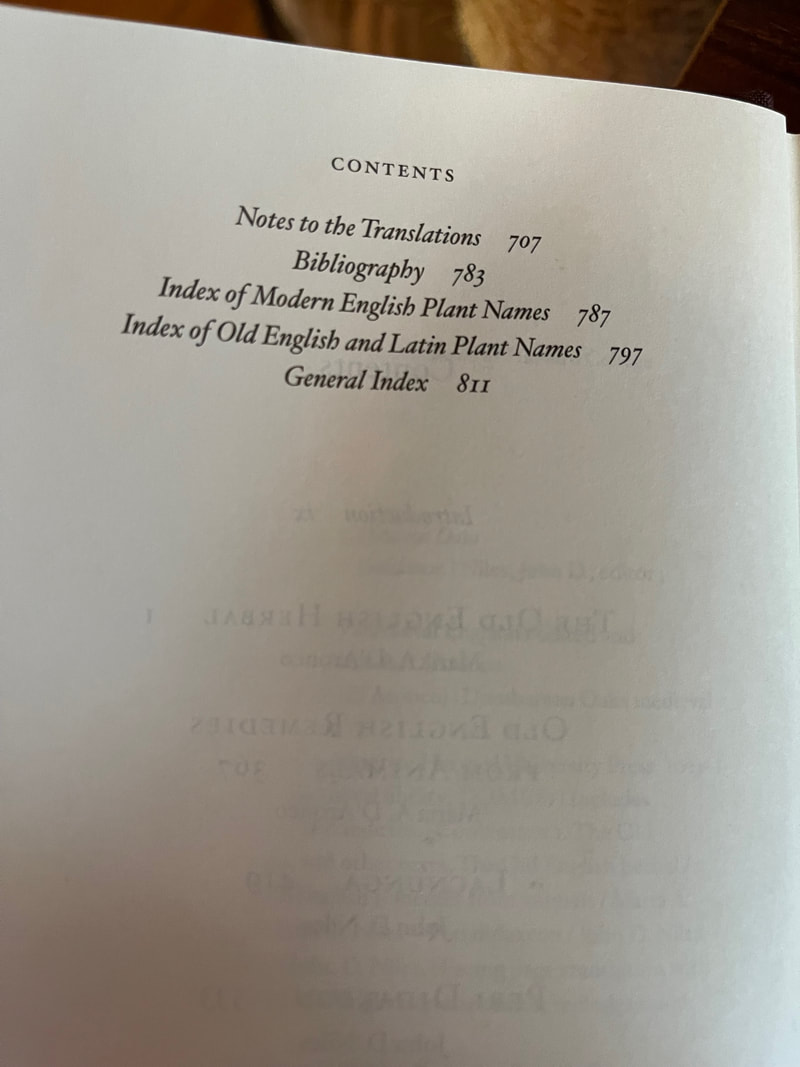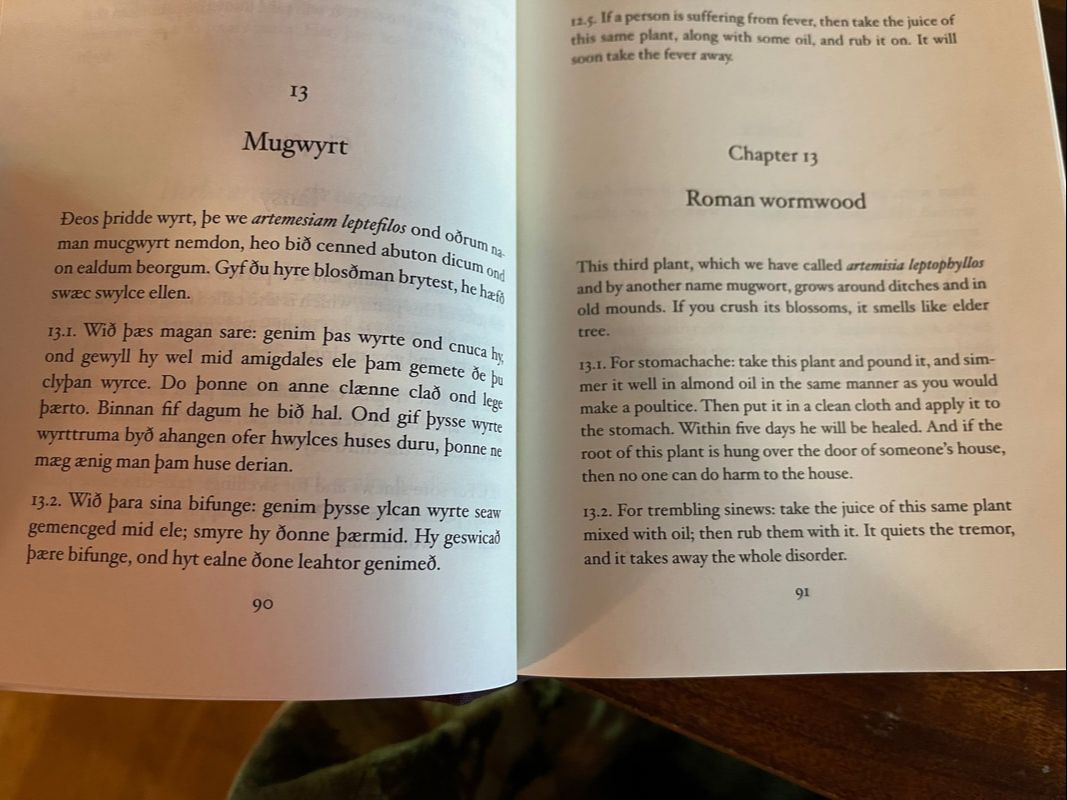|
I have to thank Elska for turning me on to this new release. I am beyond excited to dive into this one.
The book is by John D Niles and Maria A. D'Aronco and I am just delighted. This volume contains the Old English Herbal, Old English Remedies, Lacnunga, Peri Didaxeon and Miscellaneous Remedies. I have the first and third in other volumes, but look forward to comparing the works. I do not have. Peri Didaxeon at all, and the Miscellaneous Remedies come from a wealth of other sources. Each item has the original text and the translation. There is an index of Old English and Latin plant names. Basically, this is going to be SO GOOD and I am very excited about having it! You can purchase the book here: https://amzn.to/3IfPGQf Description from Amazon: Unlike elsewhere in Europe, vernacular writings on health and healing had a major place in early medieval England. These texts―unique local remedies and translations of late antique Latin treatises―offer insights into the history of science and medicine, social history, scribal practices, and culture. Some cures resemble ones still used today; others are linguistically extravagant, prescribing ambitious healing practices. Alongside recipes for everyday ailments such as headaches are unparalleled procedures for preventing infant mortality, restoring lost cattle, warding off elf-shot, or remedying the effects of flying venom. Medical Writings from Early Medieval England presents the first comprehensive edition and translation from Old English of these works in more than 150 years. Volume I includes The Old English Herbal, Remedies from Animals, Lacnunga, the Peri Didaxeon, and a compendium of miscellaneous texts. Table of contents and sample below: |
|
0 Comments
Typically I fall in love with a material culture (usually clothing) and learn about the garments, build a wardrobe and then start to learn other information to more fulling try to build out a persona. This approach rarely gets me very far into the persona building, but I have a great time with what I do craft and learn.
With my SCA Forestry/14th Century project I made an outfit just to get started, and dove right in on the herbs. Before I go further I am really diving into reading to build a better framework from the ground up. To be fair, this is also much easier to research with an aim towards persona building than anything I have done before. The materials are readily available and mostly in English. This is entirely unheard of for me, and it is rather refreshing. You can view most of my library for this subject matter HERE, though I still do have a few more books to add. Below I am going to review two of the items that read this past month that immensely helped me set the stage for the work I plan to keep doing.
I have three books I am tackling next. Two are based on the works of the ancient physician Galen (129-216BCE), as this knowledge was still studied and in use in the Middle Ages. The first is The Alphabet of Galen and the other is Galen: SelectedWorks. The other book that is currently sitting next to me, just waiting to be picked up is Popular Medicine in the Thirteenth Century England by Tony Hunt. I hope to review these as I read them as well.
A Wandering Elf participates in the Amazon Associates program and a small commission is earned on qualifying purchases. This commission allows the purchase of more books! My list of resources for plants, plantlore and medicine for this project is below. I will keep this sheet updated, and add the link to each blog post as needed. (UPDATED: September 19, 2022.)
Anglo-Norman Dictionary, University of Aberystwyth. https://anglo-norman.net/anglo-norman.net/ Arsdall, Anne Van. Medieval Herbal Remedies: The Old English Herbarium and Anglo-Saxon Medicine, Routledge, 2010. Backx-de Groot, Githa. "Historical overview of herbal medicine from ancient to modern times", Utrecht University, 2013. Biggam, Carole. "Magic and Medicine - Early Medieval Plant-Name Studies", Leeds Studies in English, University of Leeds, 2013. Black, Maggie. The Medieval Cookbook, The J. Paul Getty Museum, 2012. Blunt, Wilfrid and Sandra Raphael. The Illustrated Herbal (Manuscripts), Metropolitan Museum of Art, 1979. Bremness, Lesley. Herbs, Dorling Kindersley, 1994. Burnett, John. "The Giustiani Medicine Chest", Medical History, Cambridge University Press, 1982. Cholmely, H. P. John of Gaddesden, Clarendon Press, 1912. Collins, Minta. Medieval Herbals: The Illustrative Tradtions, The British Library, 2000. Cogliati Arano, Luisa. The Medieval Health Handbook – Tacuinum Sanitatis, George Brazukker, Inc, 1976. Dave’s Garden, Plant Files, davesgarden.com Dictionary of Old English Plant Names, 2007-2022. http://oldenglish-plantnames.org/preface Dean, Jenny. A Heritage of Color, Search Press, 2014. Dendle, Peter and Alain Touwaide. Health and Healing from the Medieval Garden, The Boydell Press, 2008. Everett, Nicholas. The Alphabet of Galen, University of Toronto Press, 2012. Fitch, John G. On Simples, Attributed to Dioscorides, Brill, 2022. Frantzen, Allen J. Food, Eating and Identity in Early Medieval England, The Boydell Press, 2014. Getz, Faye M. Healing and Society in Medieval England, University of Wisconsin Press, 2010. Hoffman, David. The Complete Illustrated Holistic Herbal, Element, 1996. Kiple, Kenneth F. The Cambridge World History of Food, Volume 1, Cambridge University Press, 2000. Kiple, Kenneth F. The Cambridge World History of Food, Volume 2, Cambridge University Press, 2000. Galen (translation by P.N. Singer). Galen, Selected Works, Oxford University Press, 1997. Getz, Faye. Healing and Society in Medieval England: A Middle English translation of the pharmaceutical writings of Gilbertus Anglicanus, University of Wisconsin Press, 2010. Greco, Gina L and Christine M. Rose. The Good Wife’s Guide, Cornell University Press, 2009. Green, Monica H. The Trotula: A Medieval Compendium of Women's Medicine, University of Pennsylvania, 2001. Hall, Alaric. "Madness, Medication - and Self-Induced Hallucination? Elleborous (and Woody Nightshare) in Anglo-Saxon England, 700-900", Magic and Medicine: Early Medieval Plant-Name Studies, University of Leeds, 2013. Henisch, Bridget A. The Medieval Cook, The Boydell Press, 2009. Hoffman, David. The Complete Illustrated Holistic Herbal, Element, 1996. Hozeski, Bruce W. Hildegarde’s Healing Plants from her Medieval Classic Physica, Beacon Press Books, 2001. Hunt, Tony. Popular Medicine in Thirteenth-Century England, Boydell & Brewer, 1990. Hunt, Tony. Plant Names of Medieval England, D.S. Brewer, 1989. Hunt, Tony. Three Receptaria from Medieval England, The Society for the Study of Medieval Languages at Oxford, 2001. Landsberg, Sylvia. The Medieval Garden, University of Toronto Press, 2003. Lang, S. J. "The 'Philomena' of John Bradmore and its Middle English Derivative: A Perspecitve on Surgery in Late Medieval England", University of St. Andrews, 1998. Lonicer, Adam. Kreuterbuch, kunstliche Conterfeytunge der Bäume, Stauden, Kreuter, Getreyde, Gewürtze, was printed in Franfort by Christian Engenolph, 1587. (Additional versions of this book were still being printed into the 18th century.) Mabey, Richard and Michael McIntyre. The New Age Herbalist, Collier Books, 1998. Mäkinen, Martii. "Between Herbals et alia: Intertextuality in Medieval English Herbals", University of Helsinki, 2006. Matterer, James L. Tacuinum Sanitatis in “Gode Cookery”, 2009. http://www.godecookery.com/tacuin/tacuin.htm McKerracher, Anglo-Saxon Crops and Weeds, Archaeopress Publishing, 2019 Meyer, J. E. The Herbalist, Meyer, 1960. Middle English Compendium, University of Michigan, 2022. https://quod.lib.umich.edu/m/middle-english-dictionary Mirrione, Claudia. "Theory and Terminology of Mixture in Galen", University of Berlin, 2017 Mount, Toni. Medieval Medicine, Amberley Publishing, 2016. Mortimer, Ian. The Time Traveler’s Guide to Medieval England, Touchstone, 2008. National Audubon Society. National Audubon Society Field Guide to North American Wildflowers, Knopf, 2001. Norri, Juhani. Dictionary of Medical Vocabulary in English, 1375-1550, Ashgate, 2016. Obaldeston, Tess Ann (Editor), Pedanius Dioscorides (Author), Dioscorides: De Materia Medica, Ibidus Press, 2000. Paavilainen, Helena M. Medieval Pharmacotherapy: Continuity and Change, Brill, 2009. Pavord, Anna. The Naming of Names, Bloomsbury USA, 2005. Peterson, Lee and Roger Tory Peterson. A Field Guide to Edible Wild Plants of Eastern and Central North America, Houghton Mifflin, 1978. Petrides, George A. and Janet Wehr. Peterson Guides - A Field Guide to Eastern Trees: Eastern United States and Canada, Houghton Mifflin, 1998. Pettit, Edward Thomas. A critical edition of the Old English Lacnunga in BL MS Harley 585, King’s College London, 1996. Plantnet.org. Plant identification application. Pollington, Stephen. Leechcraft: Early English Charms, Plantlore and Healting, Anglo-Saxon Books, 2011. Pseudo-Apuleius Platonicus (4th Century CE), 1428-1500, Publisher - Johannes Philippus de Lignamine, 1428-1500. Metropolitan Museum of Art: https://www.metmuseum.org/art/collection/search/365881 Pseudo-Apuleius Platonicus (4th Century CE), Bodleian Library MS. Ashmole 1431, 1070-1100, Canterbury, Digital Bodleian. https://digital.bodleian.ox.ac.uk/objects/98127ed0-4bde-41e0-a93a-98a185b01de8/surfaces/3ec57965-769e-4ed2-8573-16fe862c7d49/ Redon, et. al. The Medieval Kitchen – Recipes from France and Italy, University of Chicago Press, 1993. Reed, Zsuzsanna Papp. "'Other Plants I Can't Name for You in English': The Plant Composition of Monastic Herb Gardens in Late Medieval England". Singer, P.N. and Philip J. van der Eijk. Galen: Works on Human Nature - Volume 1 - Mixtures, Cambridge University Press, 2018. Di Gennaro Splendore, B. (2021). The Triumph of Theriac, Nuncius, 36(2), 431-470, Brill. Sullivan, Karen. The Complete Family Guide to Natural Home Remedies, Element, 1997. Touwaide, Alain and Peter Dendle. Health and Healing from the Medieval Garden, 2008. Trease, G. E. and J. H. Hodson. "The inventory of John Hexham, a 15th Century Apothecary", Medical History, Cambridge University Press, 2012. The Tudor Pattern Book, Bodleian Library MS. Ashmole 1504. Wildflower.org. Plant Database, The University of Texas at Austin. Zupko, Ronald Edward. "Medieval Apothecary Weights and Measures: The Principal Units of England and France", Pharmacy in History, Volume 32, Number 2, University of Wisconsin Press, 1990. JStore Link. A Wandering Elf participates in the Amazon Associates program and a small commission is earned on qualifying purchases. This commission becomes more books! Thank you! |
SCA ForestryThis page is dedicated to my project and research related to SCA Forestry Guild activities and my expanding medieval apothecary. Here I will build out a 14th Century English men's kit and have some adventures in the woodlands! Archives
September 2023
A Wandering Elf participates in the Amazon Associates program and a small commission is earned on qualifying purchases. This commission becomes more books! Categories
All
|




 RSS Feed
RSS Feed